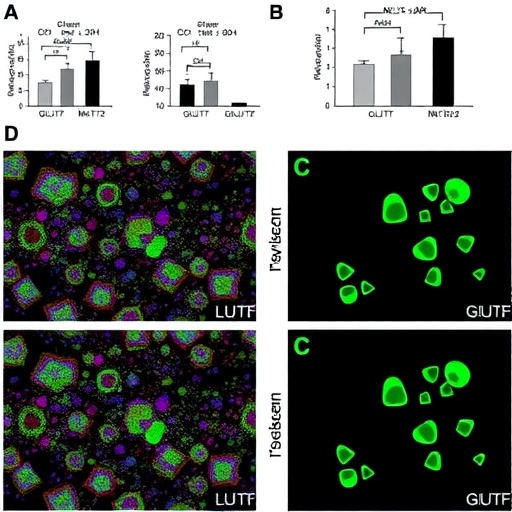In recent years, the intricate interplay between cancer cells and their surrounding microenvironment has emerged as a critical frontier in oncological research. Acute leukemia, a notoriously aggressive blood cancer, exemplifies a malignancy deeply influenced not only by the genetic aberrations within leukemic cells but also by the supportive niches in the bone marrow that shelter and nurture malignant populations. Groundbreaking research published this year highlights a novel theranostic approach targeting the chemokine receptor CXCR4, utilizing the agents pentixafor and pentixather, to disrupt these pathological microenvironmental interactions. This dual diagnostic and therapeutic strategy could mark a paradigm shift in the management of acute leukemia, offering new hope in overcoming treatment resistance and disease relapse.
At the heart of this emergent concept lies the chemokine receptor CXCR4, a G protein-coupled receptor widely expressed on hematopoietic stem cells and implicated in cell homing and retention within the bone marrow. In acute leukemia, leukemic blasts exploit CXCR4-mediated signaling to anchor themselves within protective microenvironments, enabling evasion from chemotherapy-induced cytotoxicity. This receptor’s pivotal role in leukemic cell trafficking and survival has positioned it as an attractive therapeutic target, but the translation from bench to bedside has faced numerous challenges, not least the capacity to both detect and effectively eradicate CXCR4-positive malignancies.
Pentixafor and pentixather represent a cutting-edge class of molecules designed for CXCR4-targeted theranostics—a fusion of therapy and diagnostics that promises precision oncology tailored to the molecular landscape of individual patients. Pentixafor, a radiolabeled peptide, binds specifically to CXCR4, enabling high-resolution positron emission tomography (PET) imaging of CXCR4 expression in vivo. This noninvasive visualization allows clinicians to map leukemic infiltration with unparalleled accuracy, stratify patients for targeted therapy, and monitor therapeutic response dynamically. Complementary to pentixafor, pentixather is a therapeutic analogue conjugated with cytotoxic radionuclides capable of delivering lethal doses of radiation directly to leukemia cells expressing CXCR4, thereby minimizing collateral damage to normal tissues.
.adsslot_QpHugbfe49{width:728px !important;height:90px !important;}
@media(max-width:1199px){ .adsslot_QpHugbfe49{width:468px !important;height:60px !important;}
}
@media(max-width:767px){ .adsslot_QpHugbfe49{width:320px !important;height:50px !important;}
}
ADVERTISEMENT
The convergence of imaging and targeted radiotherapy in this theranostic duo addresses a long-standing unmet need in acute leukemia treatment: the eradication of minimal residual disease (MRD) within sanctuary sites such as the bone marrow microenvironment. These niches shelter leukemic stem cells that are innately resistant to conventional chemotherapy, often precipitating relapse. By leveraging the high affinity of pentixafor and pentixather for CXCR4, clinicians can not only visualize these elusive cell populations but also deliver focused radiotherapeutic agents to annihilate them. This targeted approach is poised to significantly improve patient outcomes by overcoming intrinsic and acquired drug resistance mechanisms.
From a biochemical perspective, the interaction of pentixafor and pentixather with CXCR4 involves precise molecular recognition within the receptor’s binding pocket, allowing selective targeting of leukemia cells. Structural modifications of these molecules have optimized their pharmacokinetics and stability, enhancing tumor-to-background ratios in imaging and maximizing delivery of therapeutic radionuclides. The radiolabeling process, employing isotopes such as Gallium-68 for pentixafor PET imaging and Lutetium-177 or Yttrium-90 for pentixather therapy, has been refined to ensure high specific activity and safety, representing a marvel of modern radiopharmaceutical chemistry.
Clinical studies conducted to date have demonstrated promising results, with patients exhibiting significant reductions in leukemic burden and manageable toxicity profiles following CXCR4-directed radioligand therapy. The integration of this approach into existing treatment protocols may enable dose reduction of systemic chemotherapy and radiation, thereby sparing patients from debilitating side effects. Moreover, the ability to personalize treatment based on PET imaging of CXCR4 expression presents an exciting avenue for precision medicine, potentially transforming the therapeutic landscape of acute leukemia from a generic to a highly individualized discipline.
Importantly, the implications of this research extend beyond acute leukemia. CXCR4 overexpression is a hallmark of multiple hematological malignancies and certain solid tumors as well, suggesting that pentixafor and pentixather theranostics could be adapted for broader oncology applications. The concept of exploiting the tumor microenvironment and its receptor-mediated interactions through personalized radioligand therapy aligns with contemporary efforts to develop smart therapies that circumvent the limitations of traditional chemotherapy and immunotherapy.
However, challenges remain before widespread clinical implementation can be realized. These include optimizing dosimetry to maximize therapeutic effect while minimizing off-target toxicity, understanding long-term outcomes and potential late effects of radionuclide therapy, and integrating this approach with emerging modalities such as CAR-T cell therapy and immune checkpoint inhibitors. Regulatory approvals and cost considerations must also be navigated vigilantly to ensure equitable patient access.
The insight gained from this CXCR4-targeted theranostic strategy highlights the importance of multidisciplinary collaboration, spanning molecular biology, nuclear medicine, hematology, and pharmacology. It underscores a broader paradigm shift in oncology, moving away from one-size-fits-all therapies toward bespoke regimens informed by molecular imaging and radionuclide therapy. Such advances fulfill the promise of smart medicine—offering treatments that are simultaneously precise, efficacious, and less burdensome to patients.
As research progresses, novel agents with improved selectivity and therapeutic indices are anticipated, alongside combinatorial regimens integrating CXCR4 theranostics with other targeted treatments, immunomodulators, or epigenetic therapies. Animal models and clinical trials will continue to refine therapeutic windows and elucidate mechanisms of resistance, fostering continuous innovation.
Ultimately, the marriage of molecular targeting and radiotheranostics in acute leukemia through pentixafor and pentixather marks a watershed moment. It exemplifies how decoding the biological crosstalk between cancer cells and their microenvironment can unlock new vulnerabilities, transform diagnostics, and inaugurate a new era of precision oncology. For patients battling acute leukemia, this heralds a future where disease control is not just a hope but an attainable reality.
Subject of Research: CXCR4-targeted theranostics in acute leukemia, focusing on disrupting leukemic cell interactions with the bone marrow microenvironment using pentixafor and pentixather.
Article Title: CXCR4-targeted theranostics in acute leukemia: disrupting leukemic cell-microenvironment interactions with pentixafor and pentixather.
Article References:
Rahimian, S., Najafi, H. & Doroudian, M. CXCR4-targeted theranostics in acute leukemia: disrupting leukemic cell-microenvironment interactions with pentixafor and pentixather. Med Oncol 42, 402 (2025). https://doi.org/10.1007/s12032-025-02924-w
Image Credits: AI Generated
Tags: bone marrow microenvironment and leukemiacancer microenvironment interactionschemokine receptors in cancer therapyCXCR4 targeting in leukemiadiagnostic and therapeutic strategies in leukemiaG protein-coupled receptors in hematologyleukemic cell survival strategiesnovel therapies for acute leukemiaovercoming treatment resistance in leukemiapentixafor therapy for blood cancerpentixather in acute leukemia treatmenttheranostic approaches in oncology





